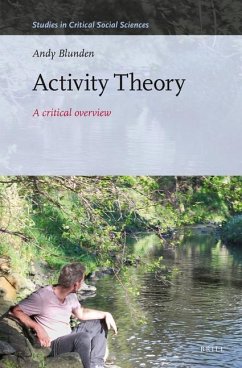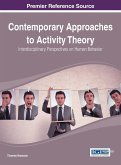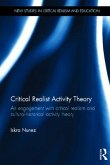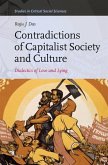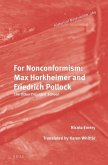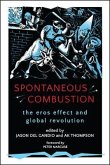- Gebundenes Buch
- Merkliste
- Auf die Merkliste
- Bewerten Bewerten
- Teilen
- Produkt teilen
- Produkterinnerung
- Produkterinnerung
Andy Blunden presents a summary of the foundations of Activity Theory and a critical review of the work of activity theorists across the world, focussing on in medical and educational contexts, concluding with a review of the ethics of collaboration.
Andere Kunden interessierten sich auch für
![Evidential Pluralism in the Social Sciences Evidential Pluralism in the Social Sciences]() Yafeng ShanEvidential Pluralism in the Social Sciences179,99 €
Yafeng ShanEvidential Pluralism in the Social Sciences179,99 €![Contemporary Approaches to Activity Theory Contemporary Approaches to Activity Theory]() Contemporary Approaches to Activity Theory187,99 €
Contemporary Approaches to Activity Theory187,99 €![Critical Realist Activity Theory Critical Realist Activity Theory]() Iskra NunezCritical Realist Activity Theory189,99 €
Iskra NunezCritical Realist Activity Theory189,99 €![Contradictions of Capitalist Society and Culture Contradictions of Capitalist Society and Culture]() Raju J DasContradictions of Capitalist Society and Culture152,99 €
Raju J DasContradictions of Capitalist Society and Culture152,99 €![Hongkongers' Fight for Freedom Hongkongers' Fight for Freedom]() Nam Kiu TsingHongkongers' Fight for Freedom158,99 €
Nam Kiu TsingHongkongers' Fight for Freedom158,99 €![For Nonconformism: Max Horkheimer and Friedrich Pollock For Nonconformism: Max Horkheimer and Friedrich Pollock]() Nicola EmeryFor Nonconformism: Max Horkheimer and Friedrich Pollock157,99 €
Nicola EmeryFor Nonconformism: Max Horkheimer and Friedrich Pollock157,99 €![Spontaneous Combustion Spontaneous Combustion]() Spontaneous Combustion100,99 €
Spontaneous Combustion100,99 €-
-
-
Andy Blunden presents a summary of the foundations of Activity Theory and a critical review of the work of activity theorists across the world, focussing on in medical and educational contexts, concluding with a review of the ethics of collaboration.
Hinweis: Dieser Artikel kann nur an eine deutsche Lieferadresse ausgeliefert werden.
Hinweis: Dieser Artikel kann nur an eine deutsche Lieferadresse ausgeliefert werden.
Produktdetails
- Produktdetails
- Verlag: Brill
- Seitenzahl: 248
- Erscheinungstermin: 20. April 2023
- Englisch
- Abmessung: 235mm x 155mm
- ISBN-13: 9789004541238
- ISBN-10: 9004541233
- Artikelnr.: 66497858
- Herstellerkennzeichnung
- Libri GmbH
- Europaallee 1
- 36244 Bad Hersfeld
- gpsr@libri.de
- Verlag: Brill
- Seitenzahl: 248
- Erscheinungstermin: 20. April 2023
- Englisch
- Abmessung: 235mm x 155mm
- ISBN-13: 9789004541238
- ISBN-10: 9004541233
- Artikelnr.: 66497858
- Herstellerkennzeichnung
- Libri GmbH
- Europaallee 1
- 36244 Bad Hersfeld
- gpsr@libri.de
Preface
Acknowledgements
List of Figures and Tables
Part 1
Basic Principles of Activity Theory
1 Introduction
1 Behaviour, Consciousness and Activity
2 Substance, Monism and Dualism
3 Continuity and Discontinuity
4 Actions, Goals and Motives
4.1 Operations
5 Artefacts
5.1 Words, Tools and Signs
6 Activities
6.1 What Is an Activity
6.2 Activities Which Fall Short of Leontyev’s Ideal-Typical Activity
7 Motivation
7.1 The “Unconscious”?
8 The Genealogy of Activity Theory
9 Activity Theory and Vygotsky’s Socio-cultural Theory
10 Germ Cell and Unit of Analysis
11 Activities and Concepts
12 Abstract and Concrete
13 Analysis by Units and Analysis by Elements
13.1 Monism Again
14 Subject, Object and Participant Research
15 Activities Have a Life Cycle
16 The Context of Activities
16.1 The Immediate and Societal Contexts of Activities
16.2 The Historical Context of Activities
17 Perezhivanie
18 The Development of the Personality
19 Narrative Analysis
20 Summary: Motivation
Part 2
Diverse Research in Activity Theory
Introduction to Part 2
2 Building Institutions
1 A Child Learning to Read.
1.1 Question Asking Reading (King, Griffin, et al.)
1.2 Putting Academic Knowledge to Work
2 Vasilyuk’s Work on Resolving “Impossible Situations”
2.1 Types of “Life-World”
2.2 Types of Perezhivanie
3 A Wage Worker Employed in a Capitalist Firm
3 Activities Characterised by a Narrative
1 The Life Course of an Individual Person
1.1 Luria’s Romantic Science
2 The Narrative of a Patient Visiting a Hospital and Receiving Treatment
2.1 The Story of a Female Trainee Surgeon Who Chooses to Leave Training
2.2 A Medical Student in Their First Months as a Hospital Doctor
3 The History of a Practice, Such as a Science or Profession
4 Transformative Projects
1 The Activist Stance
1.1 Agency
1.1.1 Vygotsky on Self-Control
1.1.2 Sannino on Collective Decision Making
1.1.3 Gutierrez on Transgression
1.1.4 Stetsenko on Agency
1.1.5 Holland and Edwards on Relational Agency
1.1.6 Horton on Freedom
1.1.7 Discussion
2 The Germ Cell of a New Practice
2.1 Marx’s Use of the Idea of a Germ Cell or Unit in Capital
2.1.1 The Introduction of Trade into a Traditional Society
2.2 Vygotsky Made Word Meaning a Unit of Analysis
2.2.1 Concepts and Activities
2.3 Vasily Davydov’s Mathematics Curriculum
5 Intervening with Activity Theory
1 Transforming Activities with a Germ Cell
1.1 The Sit-to-Stand Exercise
1.2 Junior Doctors Using Purple Pen for Prescribing
1.3 Collaborative Learning Spaces
1.4 The “Root Model” for Teaching Topics in School
6 Political Life
1 A Trade Union Organising Workers in an Enterprise
2 Rival Political Parties Competing for Government of the Country
2.1 Elections
2.2 The Formation of Public Opinion
7 Social Movements
1 The Women’s Liberation Movement
1.1 The Life Cycle of the wlm
1.2 The wlm as a Learning Process
1.3 Decision Making within Projects
1.4 Transforming the Object-Concept
1.5 Relations between Projects
1.6 The Urpraxis of a Movement
8 Incoherent Activities
1 Activities Characterised by a Shared Motif
1.1 The Solar Punk Youth Movement
1.2 The Anti-vax Campaign against Public Health Measures
9 Formative Interventions
1 Construction of Utopian Forms of Activity as Educational Artefacts
1.1 Mike Cole et al.’s 5th Dimension
1.2 Aydin Bal’s Learning Lab
1.3 Fernanda Liberali’s lace
2 Postcolonial Projects
10 Ethics
1 The Ethics of Collaboration
1.1 Social Science and Ethics
1.2 Modern Ethics
1.2.1 Religion and Ethics
1.2.2 John Rawls’ Political Liberalism
1.2.3 Habermas’s Communicative Ethics
1.2.4 Seyla Benhabib
1.2.5 Amartya Sen
1.2.6 Agnes Heller
1.2.7 Alasdair MacIntyre
1.2.8 Thick and Thin Ethos
1.3 Collaborative Ethics
1.4 Participant Researchers
2 Social Class
3 The Urpraxis of Socialism
3.1 The Worldwide Anti-capitalist Struggle
Conclusion
References
Index
Acknowledgements
List of Figures and Tables
Part 1
Basic Principles of Activity Theory
1 Introduction
1 Behaviour, Consciousness and Activity
2 Substance, Monism and Dualism
3 Continuity and Discontinuity
4 Actions, Goals and Motives
4.1 Operations
5 Artefacts
5.1 Words, Tools and Signs
6 Activities
6.1 What Is an Activity
6.2 Activities Which Fall Short of Leontyev’s Ideal-Typical Activity
7 Motivation
7.1 The “Unconscious”?
8 The Genealogy of Activity Theory
9 Activity Theory and Vygotsky’s Socio-cultural Theory
10 Germ Cell and Unit of Analysis
11 Activities and Concepts
12 Abstract and Concrete
13 Analysis by Units and Analysis by Elements
13.1 Monism Again
14 Subject, Object and Participant Research
15 Activities Have a Life Cycle
16 The Context of Activities
16.1 The Immediate and Societal Contexts of Activities
16.2 The Historical Context of Activities
17 Perezhivanie
18 The Development of the Personality
19 Narrative Analysis
20 Summary: Motivation
Part 2
Diverse Research in Activity Theory
Introduction to Part 2
2 Building Institutions
1 A Child Learning to Read.
1.1 Question Asking Reading (King, Griffin, et al.)
1.2 Putting Academic Knowledge to Work
2 Vasilyuk’s Work on Resolving “Impossible Situations”
2.1 Types of “Life-World”
2.2 Types of Perezhivanie
3 A Wage Worker Employed in a Capitalist Firm
3 Activities Characterised by a Narrative
1 The Life Course of an Individual Person
1.1 Luria’s Romantic Science
2 The Narrative of a Patient Visiting a Hospital and Receiving Treatment
2.1 The Story of a Female Trainee Surgeon Who Chooses to Leave Training
2.2 A Medical Student in Their First Months as a Hospital Doctor
3 The History of a Practice, Such as a Science or Profession
4 Transformative Projects
1 The Activist Stance
1.1 Agency
1.1.1 Vygotsky on Self-Control
1.1.2 Sannino on Collective Decision Making
1.1.3 Gutierrez on Transgression
1.1.4 Stetsenko on Agency
1.1.5 Holland and Edwards on Relational Agency
1.1.6 Horton on Freedom
1.1.7 Discussion
2 The Germ Cell of a New Practice
2.1 Marx’s Use of the Idea of a Germ Cell or Unit in Capital
2.1.1 The Introduction of Trade into a Traditional Society
2.2 Vygotsky Made Word Meaning a Unit of Analysis
2.2.1 Concepts and Activities
2.3 Vasily Davydov’s Mathematics Curriculum
5 Intervening with Activity Theory
1 Transforming Activities with a Germ Cell
1.1 The Sit-to-Stand Exercise
1.2 Junior Doctors Using Purple Pen for Prescribing
1.3 Collaborative Learning Spaces
1.4 The “Root Model” for Teaching Topics in School
6 Political Life
1 A Trade Union Organising Workers in an Enterprise
2 Rival Political Parties Competing for Government of the Country
2.1 Elections
2.2 The Formation of Public Opinion
7 Social Movements
1 The Women’s Liberation Movement
1.1 The Life Cycle of the wlm
1.2 The wlm as a Learning Process
1.3 Decision Making within Projects
1.4 Transforming the Object-Concept
1.5 Relations between Projects
1.6 The Urpraxis of a Movement
8 Incoherent Activities
1 Activities Characterised by a Shared Motif
1.1 The Solar Punk Youth Movement
1.2 The Anti-vax Campaign against Public Health Measures
9 Formative Interventions
1 Construction of Utopian Forms of Activity as Educational Artefacts
1.1 Mike Cole et al.’s 5th Dimension
1.2 Aydin Bal’s Learning Lab
1.3 Fernanda Liberali’s lace
2 Postcolonial Projects
10 Ethics
1 The Ethics of Collaboration
1.1 Social Science and Ethics
1.2 Modern Ethics
1.2.1 Religion and Ethics
1.2.2 John Rawls’ Political Liberalism
1.2.3 Habermas’s Communicative Ethics
1.2.4 Seyla Benhabib
1.2.5 Amartya Sen
1.2.6 Agnes Heller
1.2.7 Alasdair MacIntyre
1.2.8 Thick and Thin Ethos
1.3 Collaborative Ethics
1.4 Participant Researchers
2 Social Class
3 The Urpraxis of Socialism
3.1 The Worldwide Anti-capitalist Struggle
Conclusion
References
Index
Preface
Acknowledgements
List of Figures and Tables
Part 1
Basic Principles of Activity Theory
1 Introduction
1 Behaviour, Consciousness and Activity
2 Substance, Monism and Dualism
3 Continuity and Discontinuity
4 Actions, Goals and Motives
4.1 Operations
5 Artefacts
5.1 Words, Tools and Signs
6 Activities
6.1 What Is an Activity
6.2 Activities Which Fall Short of Leontyev’s Ideal-Typical Activity
7 Motivation
7.1 The “Unconscious”?
8 The Genealogy of Activity Theory
9 Activity Theory and Vygotsky’s Socio-cultural Theory
10 Germ Cell and Unit of Analysis
11 Activities and Concepts
12 Abstract and Concrete
13 Analysis by Units and Analysis by Elements
13.1 Monism Again
14 Subject, Object and Participant Research
15 Activities Have a Life Cycle
16 The Context of Activities
16.1 The Immediate and Societal Contexts of Activities
16.2 The Historical Context of Activities
17 Perezhivanie
18 The Development of the Personality
19 Narrative Analysis
20 Summary: Motivation
Part 2
Diverse Research in Activity Theory
Introduction to Part 2
2 Building Institutions
1 A Child Learning to Read.
1.1 Question Asking Reading (King, Griffin, et al.)
1.2 Putting Academic Knowledge to Work
2 Vasilyuk’s Work on Resolving “Impossible Situations”
2.1 Types of “Life-World”
2.2 Types of Perezhivanie
3 A Wage Worker Employed in a Capitalist Firm
3 Activities Characterised by a Narrative
1 The Life Course of an Individual Person
1.1 Luria’s Romantic Science
2 The Narrative of a Patient Visiting a Hospital and Receiving Treatment
2.1 The Story of a Female Trainee Surgeon Who Chooses to Leave Training
2.2 A Medical Student in Their First Months as a Hospital Doctor
3 The History of a Practice, Such as a Science or Profession
4 Transformative Projects
1 The Activist Stance
1.1 Agency
1.1.1 Vygotsky on Self-Control
1.1.2 Sannino on Collective Decision Making
1.1.3 Gutierrez on Transgression
1.1.4 Stetsenko on Agency
1.1.5 Holland and Edwards on Relational Agency
1.1.6 Horton on Freedom
1.1.7 Discussion
2 The Germ Cell of a New Practice
2.1 Marx’s Use of the Idea of a Germ Cell or Unit in Capital
2.1.1 The Introduction of Trade into a Traditional Society
2.2 Vygotsky Made Word Meaning a Unit of Analysis
2.2.1 Concepts and Activities
2.3 Vasily Davydov’s Mathematics Curriculum
5 Intervening with Activity Theory
1 Transforming Activities with a Germ Cell
1.1 The Sit-to-Stand Exercise
1.2 Junior Doctors Using Purple Pen for Prescribing
1.3 Collaborative Learning Spaces
1.4 The “Root Model” for Teaching Topics in School
6 Political Life
1 A Trade Union Organising Workers in an Enterprise
2 Rival Political Parties Competing for Government of the Country
2.1 Elections
2.2 The Formation of Public Opinion
7 Social Movements
1 The Women’s Liberation Movement
1.1 The Life Cycle of the wlm
1.2 The wlm as a Learning Process
1.3 Decision Making within Projects
1.4 Transforming the Object-Concept
1.5 Relations between Projects
1.6 The Urpraxis of a Movement
8 Incoherent Activities
1 Activities Characterised by a Shared Motif
1.1 The Solar Punk Youth Movement
1.2 The Anti-vax Campaign against Public Health Measures
9 Formative Interventions
1 Construction of Utopian Forms of Activity as Educational Artefacts
1.1 Mike Cole et al.’s 5th Dimension
1.2 Aydin Bal’s Learning Lab
1.3 Fernanda Liberali’s lace
2 Postcolonial Projects
10 Ethics
1 The Ethics of Collaboration
1.1 Social Science and Ethics
1.2 Modern Ethics
1.2.1 Religion and Ethics
1.2.2 John Rawls’ Political Liberalism
1.2.3 Habermas’s Communicative Ethics
1.2.4 Seyla Benhabib
1.2.5 Amartya Sen
1.2.6 Agnes Heller
1.2.7 Alasdair MacIntyre
1.2.8 Thick and Thin Ethos
1.3 Collaborative Ethics
1.4 Participant Researchers
2 Social Class
3 The Urpraxis of Socialism
3.1 The Worldwide Anti-capitalist Struggle
Conclusion
References
Index
Acknowledgements
List of Figures and Tables
Part 1
Basic Principles of Activity Theory
1 Introduction
1 Behaviour, Consciousness and Activity
2 Substance, Monism and Dualism
3 Continuity and Discontinuity
4 Actions, Goals and Motives
4.1 Operations
5 Artefacts
5.1 Words, Tools and Signs
6 Activities
6.1 What Is an Activity
6.2 Activities Which Fall Short of Leontyev’s Ideal-Typical Activity
7 Motivation
7.1 The “Unconscious”?
8 The Genealogy of Activity Theory
9 Activity Theory and Vygotsky’s Socio-cultural Theory
10 Germ Cell and Unit of Analysis
11 Activities and Concepts
12 Abstract and Concrete
13 Analysis by Units and Analysis by Elements
13.1 Monism Again
14 Subject, Object and Participant Research
15 Activities Have a Life Cycle
16 The Context of Activities
16.1 The Immediate and Societal Contexts of Activities
16.2 The Historical Context of Activities
17 Perezhivanie
18 The Development of the Personality
19 Narrative Analysis
20 Summary: Motivation
Part 2
Diverse Research in Activity Theory
Introduction to Part 2
2 Building Institutions
1 A Child Learning to Read.
1.1 Question Asking Reading (King, Griffin, et al.)
1.2 Putting Academic Knowledge to Work
2 Vasilyuk’s Work on Resolving “Impossible Situations”
2.1 Types of “Life-World”
2.2 Types of Perezhivanie
3 A Wage Worker Employed in a Capitalist Firm
3 Activities Characterised by a Narrative
1 The Life Course of an Individual Person
1.1 Luria’s Romantic Science
2 The Narrative of a Patient Visiting a Hospital and Receiving Treatment
2.1 The Story of a Female Trainee Surgeon Who Chooses to Leave Training
2.2 A Medical Student in Their First Months as a Hospital Doctor
3 The History of a Practice, Such as a Science or Profession
4 Transformative Projects
1 The Activist Stance
1.1 Agency
1.1.1 Vygotsky on Self-Control
1.1.2 Sannino on Collective Decision Making
1.1.3 Gutierrez on Transgression
1.1.4 Stetsenko on Agency
1.1.5 Holland and Edwards on Relational Agency
1.1.6 Horton on Freedom
1.1.7 Discussion
2 The Germ Cell of a New Practice
2.1 Marx’s Use of the Idea of a Germ Cell or Unit in Capital
2.1.1 The Introduction of Trade into a Traditional Society
2.2 Vygotsky Made Word Meaning a Unit of Analysis
2.2.1 Concepts and Activities
2.3 Vasily Davydov’s Mathematics Curriculum
5 Intervening with Activity Theory
1 Transforming Activities with a Germ Cell
1.1 The Sit-to-Stand Exercise
1.2 Junior Doctors Using Purple Pen for Prescribing
1.3 Collaborative Learning Spaces
1.4 The “Root Model” for Teaching Topics in School
6 Political Life
1 A Trade Union Organising Workers in an Enterprise
2 Rival Political Parties Competing for Government of the Country
2.1 Elections
2.2 The Formation of Public Opinion
7 Social Movements
1 The Women’s Liberation Movement
1.1 The Life Cycle of the wlm
1.2 The wlm as a Learning Process
1.3 Decision Making within Projects
1.4 Transforming the Object-Concept
1.5 Relations between Projects
1.6 The Urpraxis of a Movement
8 Incoherent Activities
1 Activities Characterised by a Shared Motif
1.1 The Solar Punk Youth Movement
1.2 The Anti-vax Campaign against Public Health Measures
9 Formative Interventions
1 Construction of Utopian Forms of Activity as Educational Artefacts
1.1 Mike Cole et al.’s 5th Dimension
1.2 Aydin Bal’s Learning Lab
1.3 Fernanda Liberali’s lace
2 Postcolonial Projects
10 Ethics
1 The Ethics of Collaboration
1.1 Social Science and Ethics
1.2 Modern Ethics
1.2.1 Religion and Ethics
1.2.2 John Rawls’ Political Liberalism
1.2.3 Habermas’s Communicative Ethics
1.2.4 Seyla Benhabib
1.2.5 Amartya Sen
1.2.6 Agnes Heller
1.2.7 Alasdair MacIntyre
1.2.8 Thick and Thin Ethos
1.3 Collaborative Ethics
1.4 Participant Researchers
2 Social Class
3 The Urpraxis of Socialism
3.1 The Worldwide Anti-capitalist Struggle
Conclusion
References
Index

